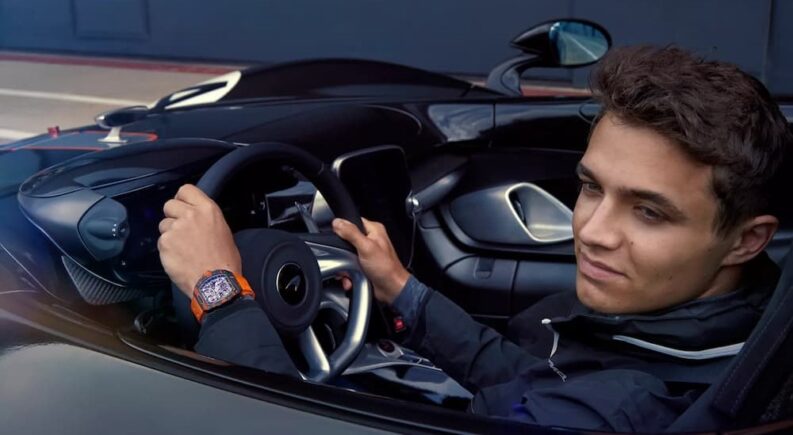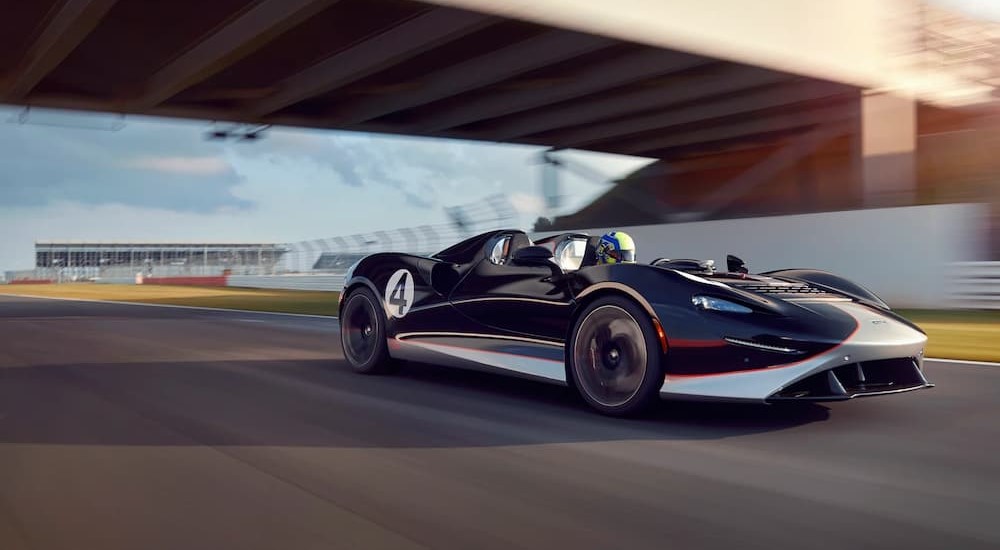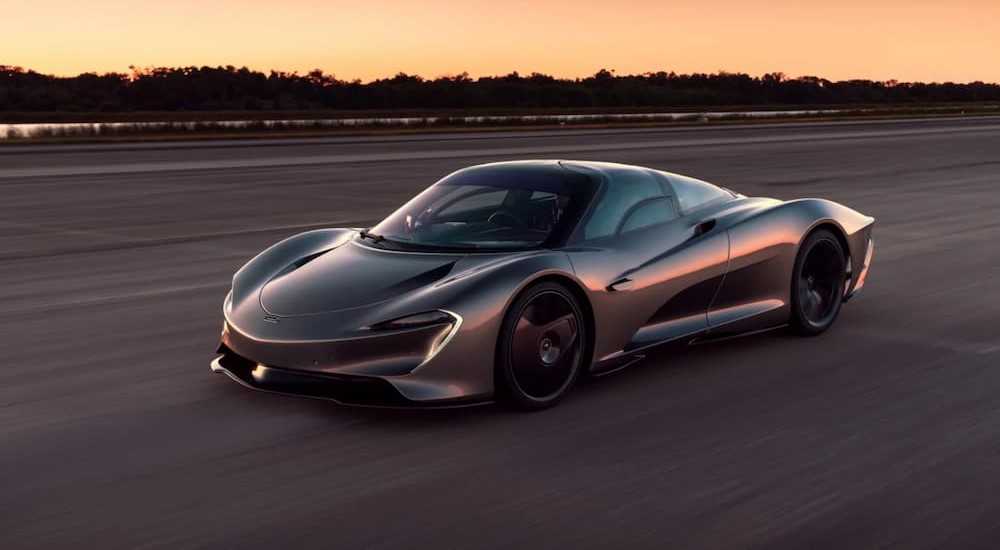One of the greatest Formula 1 legacies in history–McLaren–paired with an iconic venue like the Daytona International Speedway is a match made in heaven. With limited knowledge of the racing circuit, I ventured to Daytona this summer with my family. We enjoyed a front-row seat to the venue, reaching out to touch the 31-degree turns and walking the 18-degree starting line. Yet, I didn’t gain a genuine appreciation of McLaren and its history until recently.
As I walked the Speedway, I imagined the cacophony of over 100,000 cheering fans mixed with the rumbling engines of the fastest cars in the world–the McLarens, Ferraris, and Lamborghinis. It’s the soundtrack of the venue where McLaren has steadily built its incredible legacy. It’s also the stage where McLaren continues to showcase its ingenuity with high-performance powerhouses that defy convention. After walking the starting line, I decided it was time to dive into McLaren’s ingenuity for myself.
The McLaren Legacy
The McLaren legacy is a rags-to-riches story steeped in perseverance and passion. New Zealand native Bruce McLaren grew up around cars, with his family owning a local service station and workshop. With open access to vehicles, he learned everything he could and honed his skills as an engineer and driver. His knack was already apparent in his teens, leading him to the United Kingdom in the late 1950s to work with Jack Brabham to hone his talents as a driver. By 1959, he joined the F1 team with Cooper Cars and made history when he became the youngest ever to win the Grand Prix at the time.
With a penchant for speed, McLaren continued racing but eventually took his experience behind the scenes and established Bruce McLaren Motor Racing in the early 1960s. His goal was to build race cars that defied every expectation of performance, speed, and ingenuity. To say he succeeded is a vast understatement.
McLaren achieved his goal with the M1A, the faster M1B, and the revolutionary M2B that solidified the McLaren name as a Formula 1 leader and innovator. The M2B marked a new era in racing, with its strong and lightweight construction inspired by the aerospace industry. That construction put the McLaren F1 team at the top of the podium in 1968, with Bruce rightly earning the title at the Belgian GP. Tragically, just two years later, Bruce lost his life in the driver’s seat of his all-new McLaren M8D Can-Am at the Goodwood Circuit in Sussex.
The McLaren team was devastated by the loss but knew the value of continuing Bruce’s legacy. “Well, we don’t have a boss, we don’t have a driver, and we don’t even have a car,” teammate and partner Teddy Mayer said. “But we do have a motor race–at Mosport in two weeks’ time–and we all owe it to Bruce to race.” McLaren’s team returned to the humble workshop, immediately got to work, and won the race two weeks later.
Leveling Up: Carbon Fiber Ingenuity
Failure often leads to the greatest successes because those moments of loss offer teachable moments and valuable lessons. With Bruce gone, McLaren faltered throughout the late 1970s until the company merged with the Project 4 Racing team led by Ron Dennis. Dennis took over operations and rehired John Barnard, a designer who would once again transform the McLaren name. How?
With years of expertise, Barnard knew and appreciated the McLaren mantra of “everything for a reason.” He recognized the value of purposeful and practical design, which is why he tasked his team with using carbon fiber composite to build the next McLaren race car. Carbon fiber composite was widely used in the aerospace industry, so why not put it to the test on the racing circuit? Barnard did precisely that, with Hercules Aerospace designing the MP4/1’s carbon fiber chassis and revolutionizing the McLaren name.
The Legendary F1
McLaren pioneered the use of carbon fiber composite in the racing industry and never looked back. This ingenious material is the bodywork behind the legendary F1 supercar, which debuted in 1992 as the fastest production car in the world after reaching a jaw-dropping speed of 240.1 mph. The F1 defies every convention as the ultimate super sports car, from its BMW engine to its seating capacity for three. With the driver’s seat in the center and two passenger seats positioned slightly behind, the F1 earned unicorn status and solidified its exclusivity with only 106 models produced.
In true McLaren fashion, the automaker spent four years diligently designing the F1 to perfection. Of course, this time was well-spent because McLaren used the F1 super sports car as the basis for the racing version–the McLaren F1 GTR. The carbon fiber body guaranteed the GTR’s lightweight design, but McLaren shed a few more pounds off the race car, added bigger wheels, better brakes, a roll cage, a rear wing, a faster steering rack, and a reinforced gearbox to ready it for the track at LeMans. Surprisingly, these performance enhancements made it less powerful than the production F1, but even that couldn’t stop the GTR from victory at 24 Hours of LeMans.
Modern Marvels: The Elva and Speedtail
Turning to the aerospace industry and its widespread use of carbon fiber, McLaren revolutionized the automotive industry. Today, that ingenuity is evident in modern marvels like the Elva and Speedtail, which showcase two unique approaches to building high-performance powerhouses that exceed every expectation of speed, style, and sophistication. These models pay homage to and extend the McLaren legacy to a new generation of drivers.
The Elva
The Elva effortlessly assumes the role of a modern speed demon, turning heads with an iconic design that lacks a roof and windshield. It optimizes driver engagement and makes history as the lightest McLaren road car in history. Moreover, it showcases McLaren’s mantra of “everything for a reason” and how the automaker consistently proves that less is always more. We see this firsthand in the hypercar’s three-panel carbon fiber construction, which features a deployable roll over protection system that heightens safety despite the open-air design.
Beyond its precisely sculpted body, the Elva has a potent heartbeat courtesy of a 4.0L twin-turbocharged V8 engine that creates the soundtrack of every drive. The engine produces over 800 hp and 590 lb-ft of torque for exceptional capability. McLaren sweetens the Elva’s packaging with its Proactive Chassis Control II system that enhances the car’s handling and responsiveness, whether chasing the horizon or rounding the corner on the track.
The Speedtail
Sharing the Elva’s penchant for speed, the Speedtail stands out from the crowd as a hybrid powerhouse with McLaren’s revolutionary carbon fiber design. The Speedtail showcases McLaren’s success in building the fastest accelerating car in the brand’s history, a goal that started with the Speedtail’s carbon fiber build. Designed for optimal aerodynamics to reduce drag, the Speedtail is ingenious because it marks the first time in automotive history that the front wheels are encased by carbon fiber.
Without wing mirrors on the doors, the Speedtail relies on cameras to heighten your visibility in the driver’s seat. The result is an extraordinary masterpiece that combines McLaren’s pioneering use of carbon fiber with innovative technologies to redefine every experience behind the wheel. As a Hyper-GT model with a hybrid powertrain that produces 1,055 hp, the Speedtail lives up to and readily defies expectations as the fastest McLaren ever built. It’s everything you expect from the McLaren name and more.
The Legacy Lives On
Walking the starting line at the Daytona International Speedway gave me a new appreciation for high-performance race cars destined and designed to push the envelope. Racing is far more than a series of left turns, especially when those turns are banked at 31 degrees, where one slip of the wheel can end in tragedy. These cars are born and bred with an insatiable penchant to perform, and I’ve seen that firsthand at the Speedway. We also see it in the McLaren legacy that lives on today, from the exclusive F1 to modern powerhouses like the Speedtail and Elva that ensure the McLaren name remains in the spotlight for building the fastest, most innovative, and most exclusive cars in the world.






